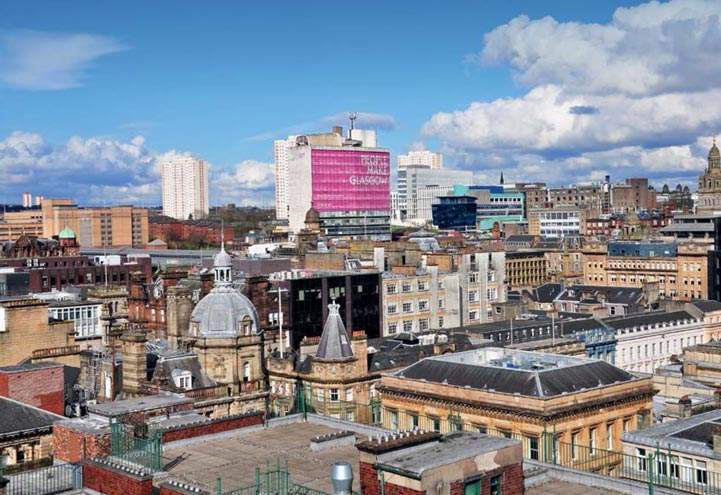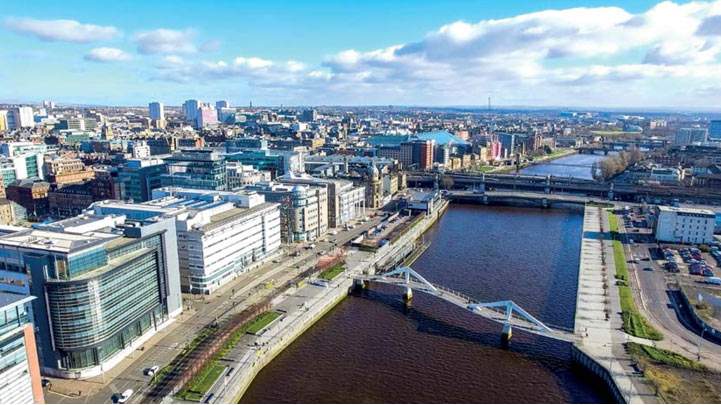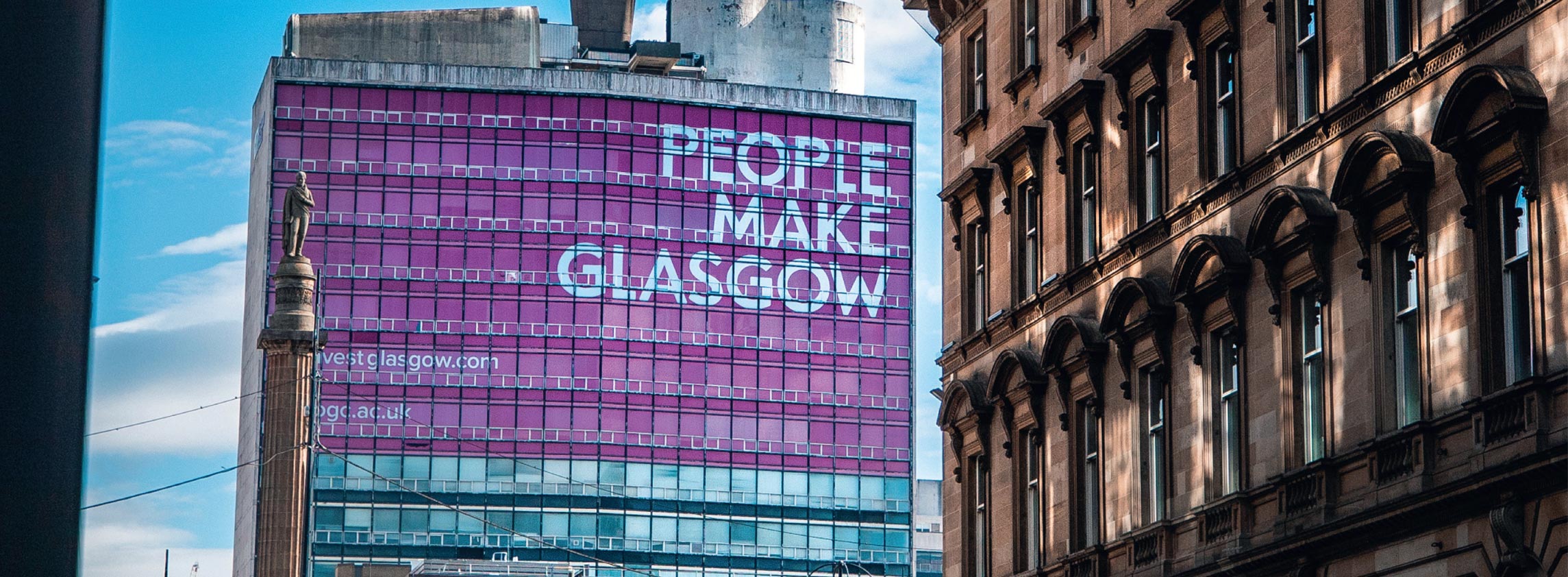Glasgow’s expanding skills and talent base is future-proofing the local economy and shaping new development in the city
Glasgow, although historically known as a centre for shipbuilding, heavy industry, manufacturing and engineering, now has a much more diverse economy with key areas in Glasgow’s economy, including tourism, financial services and the growing technology sector. But Glasgow is more than just an important economic centre. In 2019, it was ranked the UK’s top cultural and creative city by the European Commission, and it has hosted a number of important events, such as the 2014 Commonwealth Games and the 2018 European Championships. More recently, Glasgow has become a centre for the global climate change response when it hosted COP26 last November, with the city’s new transport strategy setting a target of reducing the distance travelled in private vehicles by 30% in support of the city’s ambition to become carbon neutral by 2030.
In the run-up to the Covid-19 pandemic, Glasgow had been through a very clear cycle of growth. The jobs base expanded, halving its unemployment rate, and developing strengths in high productivity sectors such as financial services, creative and technology. In spite of the pandemic, this trend is forecast to continue, with the Glasgow City Region economy expected to recover more quickly than any other region in Scotland. GVA is predicted to grow by 25% over the next 15 years, compared to 13% over the previous 15 years.
The Glasgow City Region houses almost half (46%) of all new jobs created in Scotland, with particularly strong growth in the TMT sector, where employment is forecast to grow by 14% in the next 10 years. This is the joint highest growth forecast for any sector in the city, and significantly higher than the forecasts for financial services (1%). The Central Belt Region contains over 100,000 businesses – nearly 60% of the total active firms in Scotland – which together account for a combined GVA of nearly £100 billion, the largest of any region in the UK outside London.
People make Glasgow
The UK-wide battle for talent is at its absolute sharpest, and Glasgow’s growing skills and talent base will help to futureproof its growing economy. As of 2019, 46% of Glasgow City Region residents have a degree, well above the UK average of 38% and higher than in Manchester and Birmingham. Glasgow also ranks in the top 10% of regions in Europe for the proportion of working-age adults with at least a degree-level qualification, as well as ranking number one among the 11 UK core cities for producing the highest number of digital tech graduates.
With the tech sector being a key growth sector within the city, data from HESA (see chart, below) shows a significant talent pool coming through the key universities into employment, with total Glasgow graduates moving into employment in the city heavily biased towards the professional, scientific and tech sectors. Almost 6,000 graduates have moved into tech jobs within the city over the last 12 months, making up almost a quarter (23%) of the graduates who go into employment within Glasgow.
How universities are promoting innovation and growth within Glasgow
Universities have also started to become more entrepreneurial in their outlook, and companies now have a greater appreciation for the expertise of academic researchers and how they can contribute to their business success. Universities also play a unique role in business start-up support - they not only finance incubators to support start-ups and contribute to their survival and growth, but these incubators are also managed by the university alongside spin-outs with other local businesses.
Glasgow City Innovation District (GCID) is the result of a successful partnership between Glasgow City Council, the University of Strathclyde, Scottish Enterprise, Glasgow Chamber of Commerce and Entrepreneurial Scotland. The GCID has brought in new jobs, a retention of talent, inward investment, and organisations with innovation at their core.
There has also been a growing success story when looking at spin-out companies from the academic institutions in Glasgow. The level of fundraising by companies that have spun out increased significantly last year, by over 300% on the previous year. This funding will lead to increasing occupier demand as the companies enable their business plans.
The University of Glasgow has also taken possession of the former Western Infirmary site, a significant milestone for the University which will enable the proposed £1 billion investment in the Gilmorehill campus. The masterplan for the site, which covers 14 acres, includes the creation of a Research and Innovation Hub housing large-scale, interdisciplinary projects and incubator space for spin-out collaborations with industry, which should support economic development in the West End.

The growth of the technology sector in Glasgow
Glasgow is now in the top three leading tech cities in the UK outside of London, with exciting tech start-ups and highly skilled talent coming out of the universities. In fact, Scotland has proven to be a highly successful ecosystem for high-growth companies. Overall, our data shows that there is a tendency for technology companies to acquire more space than they had before the Covid-19 pandemic began. 2021 saw the annual total of VC raised for Glasgow increase by 135% to £43m; however, so far this year we have recorded growth of 281% to just over £165m. This overall level of capital raised, which will impact positively on real estate demand and the company’s growth, will further establish the Glasgow technology ecosystem going forward.
A mix of workspace for Glasgow’s growing businesses
The city also has a real appetite for change, with a shift towards more sustainable buildings and infrastructure that will make neighbourhoods better places to live and work. This drive towards sustainable and low carbon buildings is not just limited to new development, as it is estimated that around 80% of the buildings that will be standing in 2045 have already been built, so a major priority is decarbonising our existing stock. Repurposing existing buildings can typically save between 50–70% of the embodied carbon associated with new construction, but retrospective projects can be challenging and costly, with greater restrictions placed on listed buildings.
The best schemes will focus on creating blended spaces that deliver the authentic, independent Glasgow experience which the city is known for
Clare Bailey, Director, Commercial Research
Despite this, we are seeing a trend emerging and developers are keen to repurpose and reuse. Glasgow’s Met Tower is a good example; a 14-storey Category B listed building in the heart of the city centre that is set to become a new hub for tech and digital businesses. It is intended that the Met Tower will be net zero in operation, following a transformation project that will retain as much of its existing fabric as possible, significantly reducing the embedded carbon impact of the re-developments.
As the real estate sector, technology and sustainability themes coalesce, developers are going to have to become fluent in the new language of development – it’s no longer good enough to just be talking about the bricks and mortar. As we look to try and continue the transformation of city centres post-Covid, owners of larger mixed-use development sites in Glasgow are going to have to figure out how to deliver schemes that clearly communicate this to the occupier. The best schemes will focus on creating blended spaces that deliver the authentic, independent Glasgow experience which the city is known for.
Residential demand
Residential occupancy in the city centre is currently low, and the values being achieved have posed viability challenges for new development. Although there is some spillover from the high values in the West End to the West of the city centre, and a pocket of higher value to the south of the University of Strathclyde, average transaction values for the majority of the area are below £175,000. The city centre population is also relatively low, with around 20,000 people.
The City Centre Transformation Plan aims to double the city centre population by 2035. This will need to be supported by wider mixed-use regeneration, creating a vibrant place that people want to both live and work in. Although the city centre saw a decline in population in 2020-21, there are signals from the market that demand is increasing as we emerge from the pandemic. Rental demand is particularly high.
Annual rental growth in the city has reached 14%, the highest of any UK Core City. Between the 2011 census and 2019, the number of PRS households in the City Centre grew by 48%. This suggests the pool of renters in Glasgow City Centre is growing rapidly and will continue to support demand for Build to Rent in the city. The demographic of those renting in this area is the “Rental Hub” group, predominantly young professionals who like to be close to amenities like shopping and nightlife. This is the core demographic group found on Multifamily Build to Rent developments in the UK, and suggests that there would be strong demand for increased purpose-built rental stock.
Currently, only 50 purpose-built rental homes are operational in Glasgow; however, there is a pipeline of almost 7,000 homes across the city. As the tech sector continues expanding and attracting a new young, mobile and well-paid workforce, high-quality rented stock will become a key solution to meeting the centre’s housing need.

The regeneration of the city centre is seen as crucial to the future success of Glasgow, and the council has set out an ambitious strategy to create a vibrant and sustainable centre that is the engine of the city’s future economic growth. The strategy aims to build on the existing office core, improve innovation linked to the universities, and increase the residential population. The strategy also links to plans for ‘20-minute neighbourhoods’, ensuring all residents can access key services in their local area within 20 minutes by foot, bicycle or public transport.
Mixed-use regeneration
A key part of this strategy is re-developing outdated space into flexible schemes that deliver a variety of uses and meet the need of Glasgow’s changing economy. A raft of emerging development plots and new activity along Argyle Street is seeing Glasgow’s long recognised golden retail ‘Z’, which refers to the shape of Glasgow’s pedestrianised Buchanan Street linking to Argyle Street and Sauchiehall Street, change shape.
With the majority of cranes in the city seen along the river, and ongoing success at St Enoch Centre, the evidence is clear to see. Meanwhile, Sauchiehall Street calls for its own revival. It presents a huge development site in itself, representing a prime inner city pitch that is well connected, however no longer plays a significant part of the successful retail locations. The beneficiaries of Sauchiehall Street’s demise as a successful retail location include Buchanan Street and, more recently, Argyle Street. The area needs some major master planning with integrated residential and mixed use.
For economic and social success, cities need to create places where people love to be, nurturing the people who live in them. It is in these ways that cities can build connected communities. Community and collaboration are key going forward, and it is essential that private and public work together to create places within the city to foster well-being and inclusivity, creating safe and accessible spaces. The redevelopment of Buchanan Galleries presents a unique opportunity to create a new and exciting mixed-use space offering the very best public space in the heart of Glasgow city centre. Landsec is working with Glasgow City Council on options to transform the area and support their strategic Covid recovery and climate aspirations. Just as St Enoch triggered the transformation of Argyle Street, we can hope the repurposing of Buchanan Street could bring the same good fortune to Sauchiehall Street as Glasgow continues to evolve.
Residential expansion
A growing residential pipeline is already beginning to emerge across the city centre and its immediate surrounds. Glasgow, as a whole, has a residential pipeline of around 30,000 units, equivalent to ten years of housing need. Over a third of this pipeline will be delivered in the city centre. Over 3,000 homes either have full permission or are currently under construction, with a further 7,500 homes working through the planning system, and another 2,500 at the pre-application stage. The main focus of this development will be around Merchant City, including the redevelopment of St Enoch shopping centre, currently planned to deliver over 1,700 homes alongside new office space, and 100 low carbon homes planned on a former car park site on Ingram Street.
Beyond residential and commercial development, transport and infrastructure will be an important part of the changing shape of the city centre
Clare Bailey, Director, Commercial Research
Slightly beyond the centre, Dundashill is a 600-home master plan that will be delivered over a number of years at Port Dundas, as part of wider regeneration of the area that aims to connect the city centre with North Glasgow. Gateway schemes, linking to the Transformational Regeneration Areas to the north and south of the city centre, and trying to bridge the barrier created by the M8, will be critical to the creation of 20-minute neighbourhoods at the edge of the city centre.
Transport and accessibility
Beyond residential and commercial development, transport and infrastructure will be an important part of the changing shape of the city centre. Over £130 million has been secured from City Deal funding and Sustrans to deliver the Avenues programme, which aims to make the streetscape more attractive, sustainable and safer for cyclists and pedestrians. The city is aiming to promote active travel and public transport as it seeks to reduce car usage.
Current travel times on foot and by public transport from Glasgow Central are shown in blue on the map; much of the future planned residential development will be within 20 minutes of two main stations, employment hubs around the financial district, as well as retail facilities. However, the north east corner of the city centre around University of Strathclyde is less well connected, and shows the relative disadvantage of the areas not served by the Glasgow Subway. These are the locations that will most need investment into pedestrian and cycling links with the wider city, as well as a focus on ensuring the facilities needed for a liveable neighbourhood are delivered locally rather than relying on those elsewhere in the city centre.
Savills has been serving Glasgow, the suburbs around it and the west of Scotland since our city centre office opened in 1998. We have some of the best properties for sale in Glasgow, and we're still the only estate agents in the city who can provide a full range of residential, commercial and rural property services, all under one roof. For more information, get in touch.
